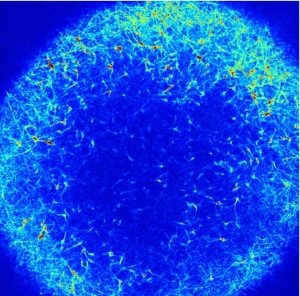One in 44 children is diagnosed with autism spectrum disorder (ASD) according to current estimates from the U.S. Centers for Disease Control and Prevention (CDC). Characterized by abnormal sociability and repetitive behaviors, ASD has been linked to hundreds of mutations but how such genetic lesions result in the distinctive pathophysiology of autism remains a mystery.
In a new study on 3D organoid models of the developing cerebral cortex generated from human induced pluripotent stem cells (iPSCs), researchers at the Broad Institute of the Massachusetts Institute of Technology (MIT) and Harvard University have found three autism risk genes converge on shared pathophysiological attributes by affecting the same type of neurons in the developing brain model, and resulting in similar neural circuit abnormalities, although they act through different molecular pathways.
The findings were published in an article in the journal Nature titled, “Autism genes converge on asynchronous development of shared neuron classes.” At present, there are no approved treatments for ASD. Insights gained from this study brings us a step closer to much needed therapeutic options.

Senior author of the paper, Paola Arlotta, PhD, professor of stem cell and regenerative biology at Harvard University and member of the Stanley Center for Psychiatric Research at the Broad Institute said, “Finding shared features among the many risk genes associated with autism may highlight common targets for broad therapeutic intervention, independent from the genetic origin of disease. These results encourage the future investigation of therapeutic approaches aimed at the modulation of shared dysfunctional brain properties.”
A cross-disciplinary and collaborative approach made the current study possible said, Joshua Levin, PhD, a scientist at the Stanley Center and the Klarman Cell Observatory at the Broad Institute and a co-author of the study.
A method developed in the Arlotta Lab facilitated the investigation. “In 2019, we published a method to allow the production of organoids with the unique ability to grow reproducibly. They consistently form the same types of cells, in the same order, as the developing human cerebral cortex,” said Silvia Velasco, PhD, postdoctoral researcher in the Arlotta lab and a co-lead author of the paper.
Arlotta added, “Scientists need experimental models of the human developing brain that can show how human genetic states (for example, mutations in ASD risk genes) affect cells of the human brain. Our goal was to use human brain organoids—promising cellular models of the human developing brain—to take this first step, converting genetic information into first understanding the disease.”
“This study is a very nice investigation of how different changes at the genetic level associated with ASD can lead to changes in the developing cerebral cortex. It’s a great example of how organoids can provide new insight into a very complex disorder, one that is unique to humans and difficult to model accurately with more traditional models like animals,” said Madeline Lancaster, PhD, a scientist at the MRC Laboratory of Molecular Biology and who was not involved in this study.
In the current study, the researchers cultured organoids from multiple iPSC cell lines from different donors with a mutation in one of three major autism risk genes: SUV420H1, ARID1B, and CHD8. “ASD risk mutations were engineered in pluripotent stem cells, which in turn were grown into organoids,” explained Arlotta.
Bruna Paulsen, PhD, a postdoctoral fellow in the Arlotta lab and co-first author of the paper said, “We decided to start with three genes that have a very broad hypothetical function. They don’t have a clear function that could easily explain what is happening in autism spectrum disorder, so we were interested in seeing if these genes were somehow doing similar things.”
In addition to proteomic analysis of whole organoids, the authors used single-cell(sc) technology including scRNA and scATAC sequencing of over 745,000 cells to identify cell type-specific neurodevelopmental abnormalities in gene expression caused by each ASD-linked mutation.
The researchers also conducted calcium imaging in intact organoids to detect abnormalities in neural circuits. “We had to develop new methods for measuring the activity of circuits in intact preparations of organoids, which was not trivial and certainly quite new in the organoid field,” said Arlotta.
The researchers found mutations in each of the three genes that act through distinct molecular pathways resulted in the asynchronous development of two major cortical neuronal lineages: inhibitory neurons that produce gamma-aminobutyric acid (GABA) as their main inhibitory neurotransmitter and deep-layer excitatory projection neurons.
Martina Pigoni, PhD, a former postdoctoral fellow in the Arlotta lab and co-lead author of the paper explained, “The cortex is made in a very orchestrated way: each type of neuron appears at a specific moment, and they start to connect very early. If you have some cells forming too early or too late compared to when they are supposed to, you might be changing the way circuits are wired.”
The out-of-phase development of similar neuronal lineages through different mutations provides clues toward a convergence of pathophysiological characteristics in autism. “We discovered something we did not know before. Distinct ASD risk genes affected the same neurons and the same developmental process (the timing and speed of generation of such cells) but largely through distinct mechanisms,” said Arlotta. “This is very important to inform new thinking about therapeutic intervention.”
“When discussing convergence among risk factors for ASD, we often focus on common versus rare genetic variation. However, we have limited insight into within-set mechanistic or phenotypic consistency (rare versus rare or common versus common),” said Elise Robinson, PhD, an assistant professor of epidemiology at the Harvard T.H. Chan School of Public Health and an institute member of the Broad Institute of MIT and Harvard, and who was not part of this study. “This study elegantly considers the different stages at which disruptive mutations in ASD-associated genes may share their functional impact and highlights the need for longitudinal modeling in functional research.”

Amanda Kedaigle, PhD, a computational biologist in the Arlotta lab and co-lead author of the paper, said, “Our goal was to see how changes in the organoids might be impacted by an individual’s unique genetic background.” Comparing organoids from different donors revealed that although the overall changes in neural development were similar, the level of severity varied across individuals. This indicated that the pathophysiological effect of the mutations is fine-tuned by genetic background.
Arlotta added, “It is puzzling how the same autism risk gene mutations often show variable clinical manifestations in patients. We found that different human genomic contexts can modulate the manifestation of disease phenotypes in organoids, suggesting that we may be able to use organoids in the future to disentangle these distinct genetic contributions and move closer to more a complete understanding of this complex pathology.”
Steven Hyman, PhD, distinguished service professor of stem cell and regenerative biology at Harvard University and the director of the Stanley Center at the Broad, and who was not involved in the current study, believes that although ASD-linked genetic risk factors are well-studied, the discovery of therapies for the complex disease depends on understanding the effects of mutations in the developing brain. Hyman said, “By mapping the alterations in brain circuits when genetic variations are present, we can take the tentative next step in the direction of better diagnoses and uncover new avenues for therapeutic exploration.”
Lancaster added, “The findings provide important new evidence for the idea that there is an imbalance in excitatory activity and inhibitory activity in the brains of autistic individuals. Such an imbalance could arise in various ways. Previous work has pointed to differences in neurons. This study reveals differences in the way those neurons are made. That has implications for when autism really first begins and would suggest that already in utero there are differences.”
Tomasz Nowakowski, PhD, assistant professor at the University of California, San Francisco, and who was not involved in the current study said, “The findings suggest that all three mutations alter the development of the human cerebral cortex by changing the patterns of neural progenitor differentiation, disrupting the balance between excitatory and inhibitory signals in the brain. These findings are highly significant as they provide a new framework for understanding how mutations in highly divergent genes may lead to autism and inspire new ideas for developing potential therapeutics for ASD.”
Nowakowski added, “This study emphasizes the importance of early developmental processes as shared etiology of ASD. If excitatory/inhibitory balance is the key point of convergence, perhaps development of therapies focused on this phenotype could have implications for a broader group of patients.”
The shortcoming of the study, Nowakowski noted, is that it is focused on only three of the hundreds of genes implicated in ASD. “It will be very interesting to see if this phenotype holds up across other genes,” he said.
In future studies, the team is enthusiastically pursuing two lines of investigation. “On one hand we want to understand whether a much larger number of ASD genes converge on the same phenotypic abnormalities observed for these first three genes,” said Arlotta. “We will also invest in studying the consequences of these early developmental abnormalities on the activity and functionality of human neural circuits.”



